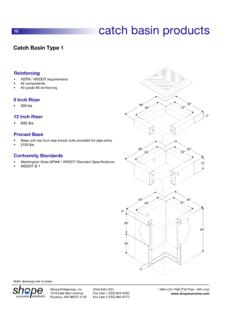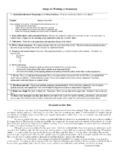Transcription of A Guide for Implementing a School Recycling
1 A Guide for Implementing aSchool Recycling ProgramReduce, Reuse, and Recycle are the key components to a comprehensive School waste reduction program. This Guide focuses on Recycling , but does not discount the importance of reduction and reuse. Table of ContentsStep 1: Do your Homework A. Assemble a Team B. Analyze the Trash 1. Generation 2. Composition 3. Percent recyclable C. Identify Markets D. Establish a Goal E. Get approval Step 2: Collection System A. Map School B. Logistics C. Containers D. Transportation Step 3: Education/Promotion Step 4: Begin Recycling ! Step 5: Evaluate programDid You Know? Additional ResourcesRecycling reduces the amount of waste going into a landfill, helping to prolong its useful life. Thirty percent of the waste disposed in the United States each year is recovered and recycled or composted, fifteen percent is burned at combustion facilities, and the remaining fifty-five percent is disposed of in landfills.
2 (Source: ) Recycling saves energy. It takes 20 times more energy to make aluminum from bauxite ore than using recycled aluminum. (Source: Aluminum Association). Recycling creates jobs. A recent study conducted by Project Performance Corporation in McLean, Virginia, concluded that in northeast and southern states, activities associated with Recycling employ over percent of the manufacturing workforce. Projected nationally, then, this study suggests that about 1 million manufacturing jobs and over $100 billion in revenue are possible through Recycling and remanufacturing activities. Recycling saves natural made from recycled material slow the depletion of non-renewable resources such as metal ores, oil, and natural gas, and reduce the encroachment of new mining and drilling operations on sensitive reduces pollution.
3 Two hundred million gallons of used oil are improperly disposed of each year. (Source: EPA) Used motor oil often turns up in our rivers, lakes, and streams. Properly Recycling the motor oil from one oil change protects a million gallons of drinking water or a year s supply for 50 people. (Source: American Petroleum Institute) Recycling provides raw materials for industry. Industry has invested millions of dollars in developing technologies for processing and manufacturing recovered materials. Newspapers collected in Virginia are used to produce 100% recycled newsprint. Carpet manufacturers need PET plastic soda bottles which they turn into a fiber for their product. A product called plastic lumber is manufactured in Virginia and uses recycled plastic bags.
4 Recycling makes a difference. A School Recycling program is a hands-on, interdisciplinary lesson that educates students about the environment, personal responsibility, community action, and solid waste management. School Recycling programs not only impact students and their families but also impact communities and the overall waste diversion in a community. Background1W h y i s r e c y c l i n g important?2 Step 1: Do your HomeworkA. assemble a teamPlanning for your School Recycling program must include the custodial staff, students, teachers, parents, School administrators and a representative of a local community Recycling program or Keep America Beautiful representative to ensure the success and sustainability of your program. Student organizations, such as the National Honor Society, Beta Club, Builders Club, 4-H Club, or environmental/ecology clubs are often successful at maintaining School Recycling : Sustaining a Recycling program can be a challenge in some schools, especially those with transient populations.
5 One way to ensure the continuation of the Recycling program is to create a Recycling notebook or scrapbook of all your local contacts, participating staff members, grants or in-kind donations received along with the organization it was received from, and a general history of your Recycling program (events, activities, competitions, etc.) When key people in your Recycling program leave, this notebook will provide important information for others to use. B. analyze the trashConducting an assessment of your School s waste stream can identify the type, quantity, and/or origin of the potential recyclable materials. This information can assist your team with formulating School Recycling goals and procurement of Recycling containers and/or other needed materials.
6 Students should complete the assessment with guidance from a teacher(s). An assessment can be done simply by recording the contents of an individual classroom, or a sampling of classrooms can participate in an assessment by sorting and weighing discarded trash. Once the trash is sorted and weighed, it can be multiplied by the number of classrooms for an estimate of the amount of trash and recyclable materials being discarded. Adding the waste from the library, computer labs, offices, cafeteria and other parts of your School will lead to a more accurate estimate of the total amount and type of waste in your School . 3part 1: how much waste does the School produce?1. Weigh a typical classroom s trash at the end of each day for one Average the weight of the trash over the five Multiply the answer to #2 by 20 to obtain an estimate of trash produced per month for a Multiply the answer for #3 by the number of classrooms to get an estimate of trash disposed by all classrooms per Do steps #1-3 for the cafeteria, library, teacher work room, office and other School areas and add the results to the total amount of trash from classrooms to obtain a monthly total.
7 (Hint: This may not be possible at some schools due to the enormous amount of waste generated, lack of storage areas in the School for the waste, and sanitary issues). Work closely with your custodial staff to estimate other areas of your School . Have custodians count the number of bags of trash collected from each area of your School during one School day. Ask them to sort and weigh one bag of trash from each of those areas to aid with estimation. In addition, a custodian may be able to estimate the weight of the recyclables disposed of in other areas of your School . examples:1. 10 lbs. + 7 lbs. + 5 lbs. + 12 lbs. + 6 lbs. = 40 classroom/week2. 40 lbs. 5 days = 8 lbs. of waste produced per classroom per day3. 8 lbs. x 20 School days = 160 lbs. of waste produced per classroom per month4. 160 lbs. x 20 classrooms = 3,200 lbs.
8 Of waste produced by all classrooms per month5. 3,200 lbs. classroom waste + 1,800 lbs. waste from other areas = 5,000 lbs. by the School per monthpart 2: What is the composition of School waste before Recycling ? 1. Separate the waste from the classroom trash bin into the following seven categories. If possible, do this waste separation activity for other areas of the School , such as the cafeteria, offices, library/media center, etc. a. Paper: newspaper, notebook paper, magazines, boxes, wrappersb. Plastic: disposable food service products (plates Styrofoam, cups, cutlery), product wrappers, food and beverage containers, markersc. Glass: marbles, food and beverage containersd. Metal: paper clips, staples, aluminum foil, food and beverage containerse. Food: classroom snacks, cafeteria food waste (Idea: Since most food waste is generated in the cafeteria, have the students, teachers, and staff separate food waste from other waste for one week in the cafeteria.)
9 The team could do this by locating waste bins labeled: Food Waste Only and Other Waste. Additionally, team members could monitor the bins during breakfast (if available) and lunch all week to ensure that the waste is separated properly for the analysis.) f. Wood: toothpicks, cedar chips, blocks, pencilsg. Other: rubber bands, fabric, balloons, mixed material ( plastic and metal) products2. Weigh the separated Average the weight of each trash Convert to a Record the data on a chart and graph the : Contact VRA for more detailed information about how to conduct a School solid waste audit at Calculation Method*The following three assessment parts can be completed in the same week. 4 Waste Disposal in Virginiapart 3: how much of the School s waste can be recycled?1. Separate recyclable materials out of each category from Step 1 (this should be materials that can be recycled in your community) in a typical classroom at the end of each day for one week.
10 Remember, just because a product can be recycled doesn t mean that it is being recycled in your community. 2. Weigh the amount in each category and average for the Multiply by 20 for the average weight per month for the classroom. If possible, do the recyclable separation for other areas of the School , such as the cafeteria, offices, library/media center, Multiply by the number of classrooms and add the weight from the library, cafeteria, teacher workroom, office and other School areas to determine the amount of recyclable materials that your School will produce in a month. 5. The Recycling team should collect all the results from Part 1-3 and set a School Recycling goal(s) based on the results. Additionally, the team should display the results (and/or charts/graphs) in a prominent location in the School .






